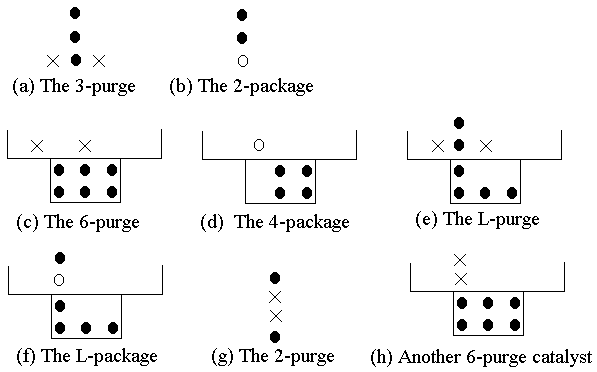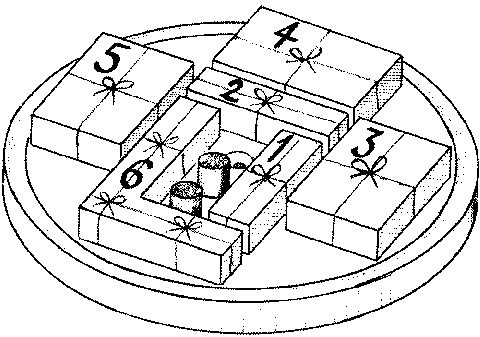Peg Solitaire
Peg Solitaire (also known as Hi-Q) has very simple rules. Pegs (red circles in this implementation) are allowed to jump over adjacent (vertically or horizontally) pegs. The peg that has been jumped over is removed. So jumps are like captures in Checkers. To move a peg, you select it first by clicking on it once. Then you click at the square (hole) to which you want the peg moved.
The goal of a regular game is to reverse a starting configuration: Positions with pegs must become empty while empty positions should be filled with pegs by the end of the game. At the beginning, you are presented with the standard configuration where just one peg - the central one - is missing. Therefore, the goal for this configuration is to end up with a single peg in the middle of the board.
Other starting configurations are available. In some, the goal is to reverse the starting configuration. In others, to end up with a single peg at the center of the board. (In the applet, there is a normally disabled checkbox Center to indicate the goal.) Configurations are selected from a combobox at the lower right corner of the applet. Do not be afraid to experiment during the play: you can always backtrack by pressing the Undo button. You are able to retract as many moves as you made in a single game.
You may try creating your own starting configuration by selecting "Design your own". The Set position button becomes enabled. When it's checked, you either set or remove pegs from the board. When unchecked, you play the game. If you discover a nice starting configuration, I'll be happy to incorporate it into the applet with due references.
The game has a very fine theory that in part demonstrates the economical manner in which mathematicians like solving their problems - they try solving smaller and simpler problems first.
| Buy this applet |
Following is an excerpt from
E.R.Berlekamp,J.H.Conway,R.K.Guy,
Winning Ways for your Mathematical Plays, v2.
PACKAGES AND PURGES
It's nice to be able to know the effect of a whole collection of moves before you make them, so let us sell you some of our instant packages. When a package is used to clear all the pegs from a region, we call it a purge.

The Figure shows the handy little 3-purge, our most popular package. When three pegs-the tail, the body and the head - are adjacent in line, this will remove them all, provided the head has an additional peg on one side of it, and an empty space on the other, as in the figure. Move 1 of the package jumps the additional peg over the head; move 2 jumps tail over body into head; and move 3 jumps over the head, back to its original position. Since the peg and the space on either side of the head are essential to the package, but are restored to their original state, we call them the catalyst.
In the Figure below, a dark dot indicates a peg to be purged, a hollow one a space to be filled, and crosses XX indicate catalyst places of which one must be full and the other empty. In most of the purges there are two catalyst moves in opposite directions over the same position (which may be a peg or an empty space) and the remaining moves form one or two packages which deliver pegs to that place. For the 3-purge (a), one peg was already in place and the second is delivered by a single jump which we might call the "2-package" (b). The 6-purge (c) is usually accomplished using a 2-package to deliver the first peg and a 4-package (d) for the second.

The L-purge (e) and L-package (f) are very useful indeed. The first peg for the L-purge is already in place and an L-package supplies the second. The first two moves of the L-package form a 2-purge (g) which can also be used in other situations. The catalyst for the 2-purge is restored in a rather unorthodox way, as is alternative catalyst for the 6-purge (h).
PACKAGES PROVIDE PERFECT PANACEA
Plenty of problems are performed with panache by people who purchase our packages.
Below we can see at a glance a solution to the Peg Solitaire, consisting of two 3-purges (1 and 2) followed by three 6-purges (3,4 and 5) and an L-purge, leaving only for the final jump to be made. You should check that every purge has a catalyst it needs.

Peg Solitaire Painlessly Packaged.
Following are two more examples:

In the left puzzle, 6 and 7 are 2-packages while 8 is a 4-package.

Picture pops prior problems.
First, take care of the middle 3-purge. What remains consists of two symmetrical configurations that can be removed by steps 5,6,7, and 8 from the upper left diagram.Reference
- E.R. Berlekamp, J.H. Conway, R.K. Guy, Winning Ways for Your Mathematical Plays, v2, Academic Press, 1982.
- M. Gardner, The Unexpected Hanging and Other Mathematical Diversions, Chicago University Press, 1991
Remark 1
If you think you have mastered the puzzle, try Reverse Solitaire. See if it does not cause you to change your mind.
Remark 2
There's a very nice application of group theory to central solitaire.
|Contact| |Front page| |Contents| |Games|
Copyright © 1996-2018 Alexander Bogomolny73595960
